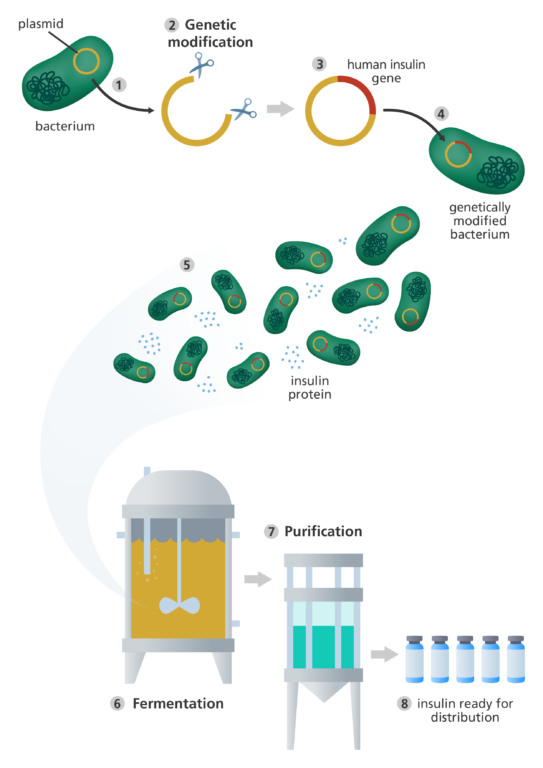What is genetic engineering?
Image credit: International Rice Research Institute (IRRI) / via WikiMedia Commons

Genetic engineering refers to the direct manipulation of DNA to alter an organism’s characteristics in a particular way.
- Genetic engineering is the process of altering an organism’s genome.
- This can range from changing one single DNA base to deleting or inserting a whole region of DNA.
- For example, genetic engineering can be used to produce more efficient or nutritious crop plants.
What is genetic engineering?
- Genetic engineering, sometimes called genetic modification, is the process of altering the DNA in an organism’s genome.
- This may mean changing one single base (A, T, C or G) to alter the function of a gene or deleting or inserting a whole gene or region of DNA. Read about the different types of genome edits here.
- In some cases, genetic engineering means extracting DNA from another organism’s genome and combining it with the DNA of that individual.
- Genetic engineering is used by scientists to enhance or modify the characteristics of an individual organism.
- For example, genetic engineering can be used to produce plants that have a higher nutritional value or can tolerate exposure to herbicides.
- It can be applied to any organism, although laws and regulations vary.
How does genetic engineering work?
- Genetic engineering tools have evolved since the 1980s, enabling scientists to make increasingly precise edits to an organism’s genome.
- You can read about some of these tools here, including TALENs and CRISPR-Cas9.
Case study: engineering bacteria or yeast cells to produce insulin
- One example of genetic engineering is to make bacteria or yeast cells produce insulin for people with diabetes.
- A small piece of circular DNA is genetically modified to include the gene that codes for human insulin.
- The genetically modified plasmid is introduced into a new bacteria or yeast cell.
- This cell then divides rapidly and starts making insulin.
- To create large amounts of the cells, the genetically modified bacteria or yeast are grown in large fermentation vessels that contain all the nutrients they need. The more the cells divide, the more insulin is produced.
- When fermentation is complete, the mixture is filtered to release the insulin.
- The insulin is then purified and packaged into bottles and insulin pens for distribution to patients with diabetes.

What else is genetic engineering used for?
Genetic engineering has a number of useful applications, including scientific research, agriculture and technology.
For agriculture
- In plants, genetic engineering has been applied to improve the resilience, nutritional value and growth rate of crops such as potatoes, tomatoes and rice.
- For example, ‘golden rice’ is a genetically engineered type of rice that produces high levels of a molecule called beta-carotene, making it a yellow-orange colour. When it is eaten, the human body can convert beta-carotene into vitamin A.
For medicine
- Some animals have been genetically engineered to produce pharmaceutical products, such as hormones, enzymes or vaccines.
- For example, goats have been engineered to produce milk that is rich in a molecule called antithrombin, which is used to prevent heart attacks and strokes in high-risk patients.
- Similarly, sheep can be engineered to produce milk containing a human enzyme called alpha-1 antitrypsin, which can treat people with cystic fibrosis and emphysema.
For research
- The first genetically modified organism to be created was a bacterium, in 1973.
- In 1974, the same techniques were applied to mice. This made it possible to investigate how specific genes function in a model organism.
- Scientists have also made nematode worms that glow in the dark to study conditions such as Alzheimer’s disease.
Case study – Alzheimer’s disease and the worm
- The nematode worm, C. elegans, only has around 300 cells in its entire nervous system. It’s also nearly transparent, making it possible to label different proteins with a fluorescent marker and watch how they affect different cells under the microscope.
- In humans, the APP gene codes for a protein associated with the amyloid plaques that are characteristic of people with Alzheimer’s disease.
- Researchers genetically engineered the nerve cells of the nematode worm to contain the APP gene, effectively giving the worm Alzheimer’s disease.
- They also tagged the resultant APP protein with a fluorescent marker. This showed that every cell that made contact with the APP protein died as the worm got older.
- The researchers were then able to monitor the progression of Alzheimer’s disease in the worm and go on to apply their findings to understanding the role of APP in humans with Alzheimer’s disease.